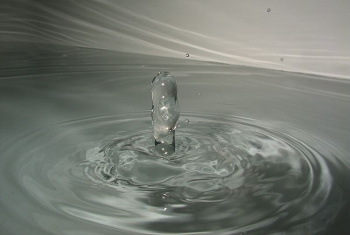Drip, Drip
August 6, 2018
During my
childhood in the
1950s and
1960s,
cable television wasn't the ubiquitous
medium that's known today. There were just your few local
broadcast television stations that tried to fill the many hours of the day with the limited content available. Most
signed-off near
midnight to the
tune of the
national anthem, accompanied by
patriotic military images. These sign-off sequences were happily supplied by the US military as a method to promote
recruitment and
public funding. As a
broadcast engineer for one such television station as a
summer job during my
college days, I watched quite a few of these.
Since
advertisers were reluctant to air
commercials on such marginal fare as "
Queen for a Day," and "The Million Dollar Movie," the planned commercial segments were filled with
public service announcements (PSAs). These included such
themes as
fire prevention with
Smokey Bear,
anti-smoking, and
weeping American Indians imploring you to "
keep America beautiful."

Smokey Bear, champion of forest fire prevention in the US.
The Smokey character was supplemented by the more cartoonish, Woodsy Owl in 1971.
Woodsy's goals are summarized in his two mottoes, "Give a hoot—don't pollute!" and "Lend a hand—care for the land!"
(Via Wikimedia Commons)
One such PSA of that era that caught my attention was an
environmentalist spot about
water conservation. It featured a
dripping water faucet, and claimed that this seemingly small leakage amounted to a
water waste of a
gallon a day. Of course, I needed to check this myself. As
astronomer,
Carl Sagan, said, "
extraordinary claims require extraordinary evidence."
As an
experimental scientist, I should have just grabbed a gallon
bottle and headed to the
sink. However, I remembered one of my
high school chemistry laboratory experiments in which we
calibrated our
eye droppers (miniature
bulb pipettes). There are about 20
drops per
milliliter, a quantity that depends on the
surface tension of the
liquid, and the
orifice. The drip rate would depend on the
hydraulic head. A drop per second is 3 milliliters per minute, or 90 milliliters per hour, and 2,160 milliliters in a day. A US gallon is 3,785 milliliters; so, there was some exaggeration.
Dripping faucets were a problem in the past, simply because the available
gasket material,
rubber, deforms over time. Today, faucet washers are made from
neoprene, which is a much more
resilient material. My house even has some "washerless faucets" that are made from closely fitting
ceramic disks with
triangular cutouts for metered water
flow.
There are a few techniques to mitigate the plink-plink
sound of the water drops of a dripping faucet before the washer is replaced, some of which I've done myself.[1]
• Wrap a towel around the faucet and direct the other end into the drain.
• Attach a piece of string, sewing thread, or dental floss, to the faucet so that the drip slides down the fiber into the drain.
• As above, but with an inexpensive necklace chain. The water will fill the loops in the chain to provide a smooth water path.
• Place a tall bottle under the faucet so that the water slides down the outside of the bottle.
• For a double basin sink, as the one in my own kitchen, direct the drips to slide down the basin divider.
• Submerse the faucet in a tall tumbler filled with water. The excess water from the drips will slide down the side of the container.
• Use the shutoff knob, typically positioned under the sink.
The
shutoff valve solution is not recommended, since replacement of this valve or its washer is more of a problem than replacing a faucet washer.

Backjet of a water droplet after impacting a water surface.
(Wikimedia Commons image by Roger McLassus)
By now, everyone has seen at least one of the many available images of water droplets hitting a water surface, an example of which is shown above. In 1908,
English physicist,
Arthur Mason Worthington (1852-1916), took the first
high speed photographs of
impacting water droplets. This topic was of just
academic interest until to advent of
inkjet printing.
Whether or not a scientist tolerates the "plink" sound of a water droplet hitting basin bottom, he should still be interested in how the sound is made. The droplet is small, the
gravitational energy supplied by fall from such a short height is small, but the sound is irritatingly loud and it has a fairly precise
audio spectrum. Not surprisingly, you don't get
research funding to study dripping faucets, so droplet sound production has only now been analyzed by a team of
engineers from
Cambridge University (Cambridge UK). Their research is reported in an
open access paper in
Scientific Reports.[2-5]
following in the hundred year tradition of Arthur Worthington, the experiment involved high speed photography of the droplet after it impacts the water. The researchers then
correlated the images with the sound that's produced. As the
authors state in their paper, this is the first time that modern high-speed video and audio capture techniques have been applied to this problem.[2] Says lead author,
Anurag Agarwal of the
Cambridge University Department of Engineering,
"A lot of work has been done on the physical mechanics of a dripping tap, but not very much has been done on the sound... But thanks to modern video and audio technology, we can finally find out exactly where the sound is coming from, which may help us to stop it."[3]
As first revealed by the Worthington photos, a droplet's
impact on a water surface causes the formation of a cavity, and this cavity quickly
recoils because of
surface tension. The result of this recoil is a rising
column of water, and the recoil is so rapid that a small
air bubble is trapped underwater.[2-3] Further experiments in the few decades after that showed that a minimum drop height is required for sound production, and they indicated that sound production was associated with the air bubble.[2]
A 1959 paper by Franz did a more thorough study using
hydrophone recordings synchronized to photographic images to show that the droplet's initial contact and the bubble entrainment were important to sound generation.[6] A short audio pulse was produced by impact, followed by a louder pulse after a delay as the crater forms.[6] While the data were suggestive, the photography was at too low a
frame rate to reveal the
physical mechanism for sound generation.[2]
Further work by Pumphrey and Crum in 1989 confirmed what Franz had discovered, and they found the underwater bubble would only form within a certain range of impact
velocities for a given droplet
diameter.[7] In his 1991
Master's thesis, Jacobus found a
linear correlation between the sound energy emitted by a drop impact and the
temperature difference between the drop and the body of water that it impacted.[2]
Some scientists are inspired by
dreams, but Agarwal was inspired to this research by
sleeplessness caused by a
roof leak. Says Agarwal,
"While I was being kept awake by the sound of water falling into a bucket placed underneath the leak, I started thinking about this problem... The next day I discussed it with my friend and another visiting academic, and we were all surprised that no one had actually answered the question of what causes the sound."[3]
The research team used an ultra-high-speed
camera, a
microphone and a hydrophone to record both the audio signals and droplet shape as it impacted a tank of water.[3] They discovered that the initial
splash, the formation of the cavity, and the jet of liquid produce very little sound, while the trapped air bubble produced the audible "plink."[3] The air bubble forces
vibration of the water surface, and the water surface produces sound in the air above.[3] The recorded audio spectrum aligns with the
theoretical natural
oscillation frequency of the air bubble, and these oscillations were observed in the video record.[2]
Video clip showing the oscillation of the trapped air bubble caused by impact of a water droplet on a water surface. The acoustic wave propagates to the water surface to produce a sound in the air above.
(Portion of an ultra slow-motion video by the University of Cambridge video, via eurekalert.org.)[4]
The
amplitude of the "plink" sound is only significant when the trapped air bubble is close to the bottom of the cavity caused by the impacting drop. This leads to the most
efficient coupling of sound from the underwater bubble to the air.[3] Changing the surface tension of the surface, as by adding
dish soap, will stop the "plink" sound.[3] The authors write that their research will enable a method for
synthesis of water droplet sounds in
video games and
movies.[3]
References:
- Drip. Drip. Drip. Please make it stop, Ask Metafilter, November 2, 2011.
- Samuel Phillips, Anurag Agarwal, and Peter Jordan , "The Sound Produced by a Dripping Tap is Driven by Resonant Oscillations of an Entrapped Air Bubble," Scientific Reports, vol. 8, Article no. 9515 (June 22, 2018). This is an open source publication with a PDF file here.
- What causes the sound of a dripping tap – and how do you stop it?, Cambridge University Press Release, June 22, 2018.
- Ultra Slow-Motion Video of Water Droplet, University of Cambridge video, eurekalert.org.
- What causes the sound of a dripping tap – and how do you stop it?, Cambridge University YouTube Video, June 22, 2018.
- G.J. Franz, "Splashes as sources of sound in liquids," The Journal of the Acoustical Society of America, vol. 31, no. 8 (August, 1959), pp. 1080-1096, https://doi.org/10.1121/1.1907831.
- Hugh C. Pumphrey and L. A. Crum, "Underwater sound produced by individual drop impacts and rainfall," The Journal of the Acoustical Society of America, vol. 85, no. 4 (April, 1989), pp. 1518-1526, https://doi.org/10.1121/1.397353.
Linked Keywords: Childhood; 1950s; 1960s; cable television; communication medium; broadcast television station; sign-off; midnight; melody; tune; The Star-Spangled Banner; national anthem; patriotism; patriotic; military; video clip; image; military recruitment; military expenditure; public funding; broadcast engineering; broadcast engineer; summer; employment; job; undergraduate education; college; advertising; advertiser; television advertisement; commercial; Queen for a Day; public service announcement; PSA; theme; fire prevention; Smokey Bear; tobacco control; anti-smoking; tears; weeping; American Indian; keep America beautiful; United States; US; cartoon; cartoonish; Woodsy Owl; motto; Wikimedia Commons; environmentalism; environmentalist; water conservation; drop (liquid); drip; tap (valve); water faucet; water; gallon; astronomer; Carl Sagan; Sagan standard; extraordinary claims require extraordinary evidence; experiment; experimental; scientist; bottle; sink; high school; chemistry; laboratory; experiment; calibration; calibrated; Pasteur pipette; eye dropper; bulb pipette; drop (unit); milliliter; surface tension; liquid; nozzle; orifice; hydraulic head; gasket; material; natural rubber; neoprene; resilience; resilient; ceramic; disk; triangle; triangular; fluid dynamics; flow; sound; towel; drain (plumbing); string; sewing thread; dental floss; fiber; necklace chain; loop; double basin sink; kitchen; tumbler (glass); shutoff knob; shutoff valve; jet (fluid); backjet; water; droplet; impact (mechanics); impacting; Roger McLassus; England; English; Arthur Mason Worthington (1852-1916); high-speed photography; high speed photograph; academia; academic; inkjet printing; gravitation; gravitational; energy; audio frequency; audio spectrum; funding of science; research funding<; engineer; Cambridge University (Cambridge UK); open-access journal; open access paper; Scientific Reports; correlation; correlated; author; Anurag Agarwal; Cambridge University Department of Engineering; classical mechanics; physical mechanics; impact (mechanics); recoil; surface tension; column; air bubble; hydrophone; sound recording; synchronization; synchronized; frame rate; physical mechanism; velocity; diameter; Master's thesis; linearity; linear; temperature; dream; insomnia; sleeplessness; roof; bucket; digital camera; microphone; splash (fluid mechanics); vibration; theory; theoretical; oscillation; frequency; video clip; water; droplet; acoustic wave; wave propagation; propagate; eurekalert.org; amplitude; energy conversion efficiency; efficient; dishwashing liquid; dish soap; synthesizer; synthesis; video game; film; movie.